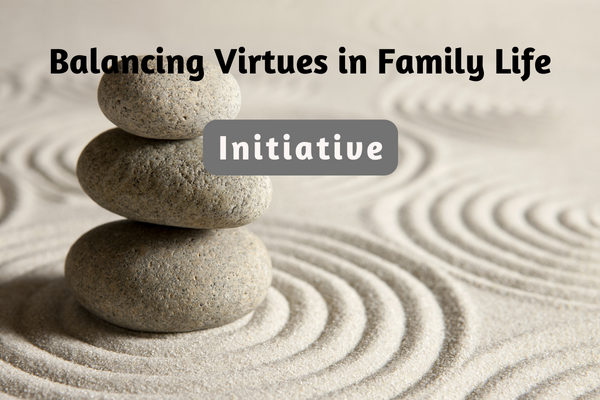
Balancing Initiative in Family Life
Finding the Right Balance for Successful Families

Initiative is originality and creativity in action. With initiative, you make things happen instead of waiting for them to happen to you.
With clarity about our values and priorities as parents, we can instill initiative in our family by setting clear expectations and goals. By defining what is important to us and our family, we create a roadmap for action, encouraging our children to take initiative in pursuing their passions and interests.
Keeping initiative balanced helps us be proactive in dealing with challenges so the family can be creative and disciplined, living the values of the family.
Picture this: you’re the captain of your family ship, steering towards your goals with grit and determination. Whether organizing the chaotic kitchen cabinets or working towards a grand family adventure, the initiative is the spark that propels us forward. It’s about seeing the vision—the bigger picture of where we want to go as a family—and taking the reins to turn that vision into reality. That’s what initiative is all about in family life—it’s the kickstart we need to make things happen and trust me, it’s worth diving into how we can balance it with everything else on our parenting plate.
Overdeveloped Initiative:
In a family, an overdeveloped initiative can sometimes manifest as overbearing parenting. Parents with excessive initiative may become overly controlling, imposing their ideas and ambitions onto their children without considering their needs and desires. While well-intentioned, this can stifle the individuality and growth of the children, causing stress and resentment.
Underdeveloped Initiative:
On the contrary, an underdeveloped initiative within a family can lead to indulgence. Parents who lack initiative might fail to set boundaries, discipline, or guide their children effectively. This can result in undisciplined and entitled children who struggle with self-motivation and personal responsibility.
Balancing Virtues:
Patience: To curb overbearing parenting, the virtue of patience is invaluable. Patience encourages parents to listen attentively to their children, allowing them the space to express their own ideas and aspirations. It fosters a nurturing environment where children can flourish at their own pace.
Responsibility: To address underdeveloped initiative, the virtue of responsibility comes into play. Parents should instill a sense of responsibility in their children by setting expectations, providing opportunities to make choices, and giving them more autonomy. This helps children learn to take initiative and be accountable for their actions.
Wisdom: Balancing initiative within a family necessitates the wisdom to discern when to lead and when to step back. Wisdom guides parents in making informed decisions regarding their children’s education, extracurricular activities, and life choices. It encourages open communication and adaptability, allowing parents to adjust their approach based on their children’s unique needs and personalities.
Courage: Courage is the strength to confront challenges and take action, even in uncertainty. By cultivating courage, individuals can break free from complacency and embark on new ventures guided by their own convictions and ideas.
Initiative in the family context thrives when tempered with patience, nurtured through a sense of responsibility, guided by wisdom, and strengthened with courage. By embracing these virtues, parents can foster an environment where their children are encouraged to express their creativity, take action, and grow into responsible and independent individuals while maintaining a loving and harmonious family unit.
Get Dad to Pull His Weight Around the House
It’s time to unleash the power of teamwork and witness the extraordinary results that await you! Click here for this article.
I invite you to sign up for our newsletter. It is a great way to get the Virtue of the Month and tips on relationships, parenting, and self-care. In addition, you’ll be the first to know about upcoming classes for successful families.
To sign up, visit the “Newsletter” section here on the website. Enter your email address, and you’ll receive our newsletter in your inbox on Wednesdays. I appreciate your interest in bringing out the best in your children and yourself. We look forward to keeping you informed through our newsletter!








